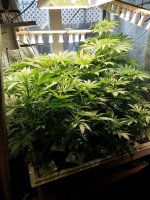QUESTION: If the increase in output below the bulbs is only ten percent then might it be better just to leave them on to increase diffusion and sideward dispersion?
No, because LEDs already have a very wide beam angle.
The diffuser of the LED bulb only adds losses and "throws" light upwards and other directions away from the plant.
Without diffuser all the light goes downwards to the canopy, and it's already radiating with a pretty wide angle.
With diffuser, part of the light is lost inside the bulb and then another part is getting lost because part of the light got redirected away from the canopy.



